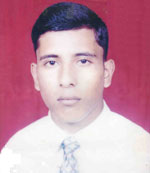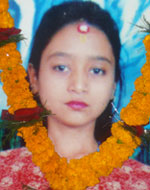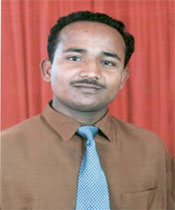Related Links
Case Updates
Krishna Adhikari
 On 6 June 2004, Krishna Prasad Adhikari, a resident of Fujel village of Gorkha District, was murdered in Chitwan District by Maoist cadres. Krishna Prasad was visiting his grandparents after having taken the SLC examinations, and he was abducted from Bakullahar Chowk by men who came on a motorcycle ...
On 6 June 2004, Krishna Prasad Adhikari, a resident of Fujel village of Gorkha District, was murdered in Chitwan District by Maoist cadres. Krishna Prasad was visiting his grandparents after having taken the SLC examinations, and he was abducted from Bakullahar Chowk by men who came on a motorcycle ... Maina Sunuwar
 Around 6 am on February 17, 2004, a group of RNA soldiers arrested Ms
Maina Sunuwar, a 15-year-old schoolgirl of Kharelthok VDC-6, Kavre
district. She disappeared since her arrest. Her family members, with
support from villagers and school where Maina was a student, visited
detention centers ...
Around 6 am on February 17, 2004, a group of RNA soldiers arrested Ms
Maina Sunuwar, a 15-year-old schoolgirl of Kharelthok VDC-6, Kavre
district. She disappeared since her arrest. Her family members, with
support from villagers and school where Maina was a student, visited
detention centers ... Sanjeev Kumar Karna
 Sanjeev Kumar Karna was one among the 11 persons arrested on October 8, 2003. On that fateful day, they had gone to attend a picnic program organized by the students at a place called Kariyachauri VDC-4, and from picnic, they went to Kataiya Chowri Area of Dhanusha district where they ate some food ...
Sanjeev Kumar Karna was one among the 11 persons arrested on October 8, 2003. On that fateful day, they had gone to attend a picnic program organized by the students at a place called Kariyachauri VDC-4, and from picnic, they went to Kataiya Chowri Area of Dhanusha district where they ate some food ... Arjun Bahadur Lama
Arjun Bahadur Lama, 48 years in age, permanent resident of Chhatrebas
VDC -5, Dapcha in Kavre district was abducted by a group of Maoist
cadres, three in number, on 29 April 2005 (2062.1.16 BS) from the
premises of Sri Krishna Secondary School at Chhatrebas VDC-1 of the
district.
» more
Hari Prasad Bolakhe
Hari Prasad Bolakhe, 35 (while missing) a permanent resident of Phulbari VDC-8, Kavre district, a pastor by profession, had been missing since the arrest December 27, 2003, was reportedly killed by security persons. A team of National Human Rights Commission discovered a human skeleton in a jungle ...
» more
Sarala Sapkota
Around 11 p.m. on July 15, 2004, a group of 12 armed soldiers arrested
Sarala Sapkota at her grandfather’s house. The family, who witnessed the
arrest, stated that soldiers gave Sarala no reason for her arrest.
After her arrest, Sarala’s family went to Baireni barracks and the DPO ...
» more
Birendra Shah
On the evening of 5 October 2007, Mr. Birendra Shah, 34, resident of Inruwasira VDC-8, Bara district, a local journalist of Bara district and correspondent of Nepal FM, Avenues Television and Dristi weekly, was abducted by Maoists from Pipara Bazaar in Kalaiya, the district headquarters of Bara ...
» more
Bishwanath Parajuli, Tom Nath Poudel and Dhan Bahadur Tamang
Three persons namely Bishwonath Parajuli (also called Nagendra
Parajuli), Tom Nath Poudel and Dhan Bahadur Tamang of Hasandaha VDC,
Morang were shot dead by the security personnel on 28 September 2004.
According to the eyewitnesses, other victims and the villagers, about 16
people were arrested ...
» more
Chot Nath Ghimire and Shekhar Nath Ghimire
Chot Nath Ghimire, a 58-year-old farmer, resident of Ishaneshor VDC-4,
Ratamate Majhpokhari of Lamjung district was allegedly arrested by the
Joint Security Forces of Joint Security Camp stationed at Bhorlatar VDC,
Lamjung district on February 2, 2002 (2058.10.20). The security camp
called Mr. ...
» more
Bhauna Tharu
Bhauna Tharu (Bhauna Chaudhary in the citizenship card), 21 years old
male (at the time of the incident; Date of Birthe: 8 September 1978),
son of Purna Bahadur Chaudhary, permanent resident of Sujanpur village,
Neulapur VDC-4, Bardiya district, and an employee of Rastriya Gobar Gas,
Gulariya, ...
» more
Appellate Courts Order Police to Slough off Slumber in Three Cases
On 12 January 2011, the Appellate Court of Nepalgunj issued an order of mandamus to the concerned authorities to initiate a prompt investigation vis-à-vis the extrajudicial execution of Patan Din Lohar and sought written reply enclosing all necessary documents with the 15 days timeframe (See Case Summary below)
Similarly, the Appellate Court, Tulsipur, on 23 November, 2010, gave clear directives to the District Police Office Dang, and District Public Prosecutor Office, Dang, "to complete the duty set down as per the law by effectively and promptly investigating into the FIR" by revving up investigation" regarding the brutal murder of eleven farmers (Asharam Chaudhari, Krishna Prasad Chaudhari, Sita Lal Chaudhari, Prasad Chaudhari, Ram Bahadur Chaudhari alias Ramu, Rupa Lal Chaudhari, Khusiram Chaudhari, Jagaman Chaudhari, Rishiram Chaudhari alias Rishman, Jogi Chaudhari, Somlal Chaudhari alias Soranga Chaudhari), by the members of the then Royal Nepal Army (RNA). (See Case Summary below)
Similarly, the Appellate Court, Tulsipur, on 23 November, 2010, gave clear directives to the District Police Office Dang, and District Public Prosecutor Office, Dang, "to complete the duty set down as per the law by effectively and promptly investigating into the FIR" by revving up investigation" regarding the brutal murder of eleven farmers (Asharam Chaudhari, Krishna Prasad Chaudhari, Sita Lal Chaudhari, Prasad Chaudhari, Ram Bahadur Chaudhari alias Ramu, Rupa Lal Chaudhari, Khusiram Chaudhari, Jagaman Chaudhari, Rishiram Chaudhari alias Rishman, Jogi Chaudhari, Somlal Chaudhari alias Soranga Chaudhari), by the members of the then Royal Nepal Army (RNA). (See Case Summary below)
In yet another decision on 19 January, 2011, the Appellate Court, Tulsipur issued a final order directing the District Police Office Dang, and District Public Prosecutor Office, Dang, "to initiate the prompt and effective investigation into the FIR set down by the State Case Act 2049" vis-à-vis the murder of three youths by the Maoists. (See Case Summary Below)
Case Summaries
Patan Din LoharPatandin Lohar, a commoner and blacksmith by profession, aged 33, resident of Phattepur-1, Jhagadiya, Banke district, was gunned down at around 1 pm on 1 December, 2001, by, a team of Nepal Police while he was answering the call of nature nearby his home. He was accused of being a Maoist. A team of Nepal Police in combat dress and others in plain clothes numbering in 50-60 had entered the village of Patan Din Lohar and searched his house before they killed him. The security forces however failed to find anything at the house of Patandin. He was shot down twice, while he was defecating at a distance of 300m far from his house, by a team of police under the command of Police Inspector Dharma Raj Sunar, Area Police Office, Bhoj Bhagawanpur, Banke. The dead body then was loaded to the tractor as ordered by the Police Inspector Dharma Bahadur Sunar. Bechan Lal Murau, Triloki Bahun and Babbu Lal Bahun helped the police to carry and load the dead body into the trailer of the tractor.
Murder of 11 farmers by then Royal Nepal Army
Eleven farmers of Bargadi were murdered by the then Royal Nepal Army on 28 November, 2001 while they were working in the paddy sifting yard that belonged to landlord Krishna Sharma. The names of these victims are as follows: Asharam Chaudhari, Krishna Prasad Chaudhari, Sitlal Chaudhari, Prasadu Chaudhari, Ram Bahadur Chaudhari, Ruplal, Khushiram Chaudhari, Jagaman Chaudhari, Rishiram Chaudhari, Jogi Chaudhari, Somlal Chaudhari. They were accused of being the supporters of Maoists. At around 3 pm, armed RNA personnel in uniform entered the village and went to the place where these victims were sifting paddy. Some army personnel said, “Comrade Red Salute!” and ordered all the victims to gather at a single place. The victims followed the order as they feared the army men. Army personnel asked them to genuflect and then they opened fire at them all. The soldiers then drove away in the red pick-up van.
Smoke was surging up in the incident spot. The victims’ family members couldn’t go to the incident spot because of the fear of the army. All except Ruplal Chaudhari were dead on the spot. Ruplal was crying for water. His wife dragged him to the hayrick, helped him lean on its support and gave him water. He could not drink water well; he only managed to drink some of it and poured it on his stomach while trying to drink. People gathered there were in dilemma whether to take him to hospital or not. They feared that soldiers may take reprisal on them if they took him to hospital. Later they decided that he should be taken to hospital. The victims’ family members started keening for their loved ones. Somlal Chaudhari’s family members took his dead body home.
Meanwhile, around 5 in the evening, the soldiers arrived there in three trucks covering their faces with masks. People gathered there began fleeing the scene fearing the soldiers. Seeing Ruplal Chaudhary alive, soldiers shot him dead and carried the ten bodies to Ghorahi. People were frightened to keep Somlal’s body at home for soldiers might come searching for it and kill others. Then they took the body back to the place of the incident. Army men came there the following morning and took it away on a truck.
Soldiers kept the dead bodies at Mahendra Hospital in Ghorahi for five to six days. Then the male members of the victims' family went there to claim the dead bodies. They went there along with the then mayor and vice-mayor of Tribhuvannagar Municipality and the ward president of the village Mohanlal Chaudhari. In the receipt it was stated that the victims had been killed in combat. When they tried to protest, army men threatened them by saying, “Sign on the receipt. The higher authorities have ordered the same. If you don’t sign, we’ll throw the corpse elsewhere and we also will do the same to you.” To save their own skin and to perform the last rites of their loved ones, they signed on the receipt. The victims’ relatives loaded them in a truck and brought them to a stream nearby Peepaldanda in Bargadi where they interred them in a row.
False news was announced from Radio Nepal and Nepal Television that RNA personnel had killed terrorists in combat at Bargadi. Those terrorists had come to loot weapons. It was also announced that a socket bomb had been found from their possession. Victims’ relatives felt that insult had been added to their injury when their innocent loved ones were killed for no reason and on top of that they were tagged as terrorists.
Murder of 3 youths by Maoists
Three youths, namely Upendra GC, Gir Bahadur Thapa and Suvas Roka, from Dang were abducted by Maoist on February 21, 2002. While the family members were searching for them, they found out the pamphlets at Bahundanda forest signed by Maoist district level leader stating that they had been “wiped out.” Though the pamphlets were found, no bodies were recovered until 9 days had passed. The anguished, terrified family members came to know the brutal killings of their loved ones and their bodies being thrown in Bahundanda forest.
After confirming the existence of the corpses, the victim’s relatives informed the police about it. However, the police showed reluctance in going to the incident spot citing the adverse condition of the country at that time. They asked the victim’s relatives to retrieve the corpses from the forest. In this way, the bereaved families were compelled to go to the incident spot taking a tripper with them. After they reached there, they found the corpses lying there in a horrible condition. All victims had been severely tortured to death. The corpses were emitting foul odor and insects had infested them. The heads had been burnt. Kerosene had been poured on the heads and fire had been set on them. The bodies had been wounded at many places with sharp weapons. There were no weapons, other goods or even any marks of struggle which indicated that the victims had been murdered elsewhere and thrown there. Suvas Thapa’s forehead and chest had been shot at while Girbahadur’s body was riddled with bullets. Moreover, one of his hands and legs had been severed from the body. His penis too had been cut out. Then, the corpses were taken to Mahendra Hospital for post-mortem. It was conducted in presence of the police who later handed the corpse over to the relatives.
























Join Us